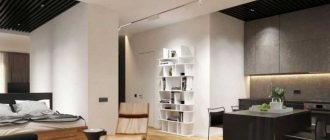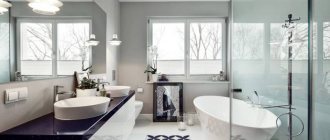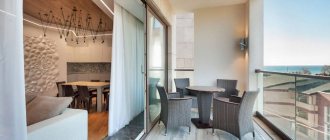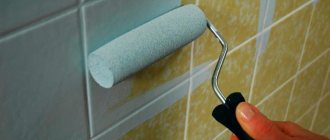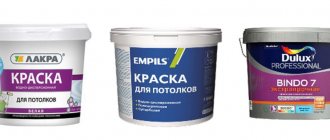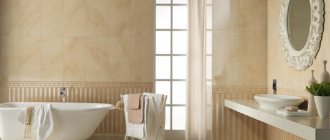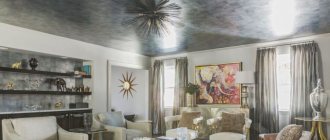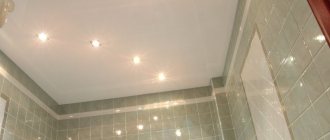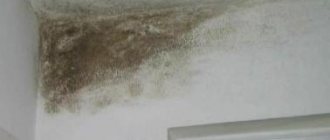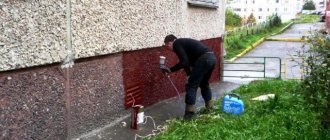General provisions
Any paint is classified according to the type of material, gloss and washability. Depending on the reflective properties of the surface, painting materials can be glossy or matte. Glossy painted ceilings are characterized by the presence of shine and high decorative characteristics. However, to apply such a coating it is necessary to carry out careful preparatory work to eliminate the slightest irregularities and defects.
As for matte paint, due to its lower reflectivity, it is able to mask minor flaws in the base base. This reduces the time and effort required for plastering or putty by an order of magnitude. An intermediate option is also available for sale - the so-called. “semi-gloss” paints: they are able to impart a certain shine to the ceiling surface, simultaneously masking minor defects and irregularities.
Depending on their ability to withstand wet cleaning, paints are either washable or non-washable. The selection of a specific option depends on the operating conditions. For rooms with a low level of pollution (bedrooms, children's rooms, living rooms), inexpensive non-washable options are quite suitable. It is better to paint a kitchen, hallway or bathroom with a washable material that can withstand regular wet cleaning with a sponge, rag and detergents without loss of decorative characteristics.
Features of water-based paints
The main option for painting the ceiling in an apartment is water-based compositions. In another way they are also called water-dispersed. Plain water is used as a solvent here. Among the ingredients there are also film-forming materials - pigments that impart covering properties to the substance. To give the paint the necessary performance properties, special additives are introduced into its composition.
The result is a liquid suspension consisting of solid components (base, pigments and additives) suspended in the liquid. A very important point is that these particles do not dissolve and do not mix with water. As a result of application to the base to be decorated, water evaporates, after which only the polymer layer of the desired color remains.
Water-dispersed paints have a number of strengths, which makes it possible to decorate not only ceilings, but also walls indoors for various purposes:
- High adhesion
. This allows the material to fit well on almost any base, forming a reliable “adhesion” with it. If the surface preparation technology is carried out correctly, there is no need to worry about peeling or swelling in the future. - High drying speed
. Usually after 2-3 hours the painted surface can be used. - No unpleasant smell
. This makes the work much easier, because... there is no need to use personal respiratory protection. This is especially appreciated when finishing large areas. The absence of harmful toxins makes the material environmentally friendly. It can be used without restrictions in any room. - Easy to apply
. Working with water-based paint usually does not cause difficulties even for a person without painting experience.
Compositions of this type also have some disadvantages:
- Temperature requirements
. Water-dispersed paints must not be used in unheated rooms where the air temperature can drop below +5 degrees. Otherwise, small cracks will appear on the finishing surface. - Humidity restrictions
. If the humidity level in the room is high, then water-based paint simply will not be able to dry: the water in its composition will have nowhere to evaporate. - Requirements for the quality of foundation preparation
. It needs to be well leveled and sanded, because... Painting this type of slope will further highlight any imperfections in the surface.
Water-based paints are acrylic, silicate, silicone, mineral and polyvinyl acetate.
Types of decorative paint for painting the ceiling
In terms of their composition, decorative paint mixtures differ little from conventional paints and varnishes: the same strength and elasticity, but the hiding power is better and should be applied in a thicker layer. The material varies according to the base, forming composition and can be silicate, acrylic, silicone. Fillers in the form of small, medium or large fractions provide relief to the structure of the finished composition.
Natural materials are used as filler: sand, chips of gas silicate stone, natural marble or polymer fiber. When choosing compositions, you should pay attention to the decorative effect; it can be multi-colored, “playing” under the lighting - luminescent. It all depends on the components included in the mixture.
Decorative paint is applied manually, has increased thickness and good adhesion to the base. Therefore, the compositions can be used to cover not only horizontal, but also vertical, overhanging planes. An additional advantage is that it can be applied in a thick layer. This means that the decor will hide defects in the ceiling base and provide good heat and sound insulation.
On a note! Manufacturers of decorative mixtures write in the instructions all the characteristics of the composition: matte/glossy effect, moisture resistance, or the need for use only in dry rooms. It is better to pay attention to these indicators to choose a certain type of paint.
The best conditions, betting odds for sporting events and this is all in one application, you can follow the phone link absolutely free and receive a bonus using the MyAndroid promotional code.
Mosaic paint is available for sale. This is a mixture that contains microcapsules with a coloring pigment. The paint can be within the same spectrum or contrasting. When sprayed from a spray gun, which is how the composition is applied, the capsules on the ceiling break, resulting in a structure similar in appearance to natural granite - multi-colored in a chaotic manner. This composition is not applied with a brush or roller; only the pressure of the spray gun ensures the necessary paint supply process so that the capsules are opened when they hit the plane of the ceiling.
On a note! Mosaic decor on the ceiling can be cleaned with damp sponges - the paint layer does not need additional protection.
If the decorative coloring composition does not suit the color shade, coloring pigments are offered for sale, which can be used to tint the compositions in any color. The pigment is sold in liquid form; it is recommended to dilute it in part of the base paint, mixing the compositions in portions until they fully match the desired shade. However, you should remember: the color of the paint is determined only after the layer has completely dried, so it is better to first test the composition on a small area of the ceiling.
Pros and cons of decorative coloring compositions
When evaluating mixtures, we can highlight the following list of advantages:
Leveling and plastering the ceiling for painting with your own hands
- Lack of work to carefully level the ceiling plane. Application of the composition in a thick layer, good hiding power - qualities that help hide minor surface defects: cracks, small chips, differences in level.
- Strength. The decor is characterized by low susceptibility to random mechanical influences. But if you act deliberately, the paint will fall off.
- Inexpensive cost. Compared to other materials, the decorative mixture costs up to $5, which means it’s affordable even for budget renovations.
- Environmentally friendly. There are no harmful components in the composition; when drying, the paint does not release substances that negatively affect health, so you can decorate ceilings in children's rooms.
- Non-flammability. The thick mass does not support combustion and self-extinguishes.
- Wide range of colors. Color solutions are limited only by the user's wishes. Using color you can give any shade to the ceiling.
- Maintainability. Repairing a ceiling painted with textured paint will not be difficult - the coating can be refreshed with acrylic-based compounds.
There are many advantages, but there are also disadvantages:
- significant consumption - up to 1.2 kg of composition is consumed per 1 m2 of ceiling surface;
- Use with caution in low-rise buildings.
The second drawback is due to the fact that during seasonal soil movements, a thick layer of decor may not withstand bending and may crack and then crumble.
In order not to make a mistake with the choice of facing material, you should read the instructions from the manufacturer. The recommendations indicate the material consumption, the technology of working with paint and the area of application of the mixture.
Acrylic paints for ceilings
Compositions of this type are made on the basis of acrylic resins: it is they, together with various additives, that form a decorative film on the surface of the ceiling. Among other options for painting the ceiling in a room, acrylic paint is the most popular. With its help you can decorate concrete, wood, polymer, steel, glass and plaster bases. The material dries very quickly, without emitting unpleasant odors or toxic substances.
Acrylic compounds are known for their durability. Once applied to the ceiling, they can last a long time without losing their decorative qualities. Such a surface is not afraid of sunlight, abrasion, peeling and crumbling. The created layer of paint allows steam to pass through, which is very convenient when decorating rooms with high humidity levels. The high adhesion of the material should be taken into account: once applied, it will not be easy to remove. Therefore, you need to decide in advance for what time this finishing is designed. In the process of preparing the base, it is recommended to use special antiseptic impregnations.
A special type of acrylic paint stands out - acrylate. Along with the standard set of components, latex was introduced into its composition. This makes it possible to impart additional unpretentiousness and durability to the material. Acrylate compounds adhere very well and adhere to the surface, masking various minor flaws in the form of cracks, crevices and base defects.
To enhance this effect, it is recommended to apply the material in two layers. In the future, the finished finish can be washed using delicate detergents. According to the manufacturers of acrylate paints, the base decorated with their help is able to withstand many washing cycles, with full preservation of the original decorative characteristics. The high performance characteristics of acrylate paints are expressed in the fairly high cost of this type of material.
How to choose ceiling paint?
There are two main types of paints based on the main component:
- Oily. Their base is drying oil, varnish, and oils. The composition is quite toxic, so it is extremely rarely used for residential areas.
- Water-based. By choosing water-based compositions, you make a choice in favor of environmental friendliness, safety, and also save your budget. They are diluted with water; during subsequent dismantling, such paint is also removed with water. However, water emulsions should not be used in areas with high humidity or on metal surfaces.
Emulsions come in several types:
- Acrylic. They dry quickly and do not fade even with permanent exposure to ultraviolet radiation on the coating. In addition, acrylic is characterized by high strength and perfectly fills microcracks and is easy to apply. Acrylic compounds are white, but if you mix white with color, you will get the color you need.
- Latex. Latex-based compositions are characterized by a high price, but at the same time they have many positive characteristics. This paint can be used to cover any texture; it is not afraid of moisture and dirt - the latex coating can even be washed! Choose this type of composition if your apartment is located in a new building. With possible shrinkage of the house, the paint layer will stretch, preventing the formation of cracks in the coating.
- Silicone. These compositions can be called a novelty in the construction market. Like the previous option, it is expensive. The coating can be applied to any surface, even with cracks up to 1 mm wide, it is resistant to humidity, dirt and even mechanical stress.
- Silicate. Made from chalk, talc and glass. The service life of silicate coating reaches 20 years, it is not afraid of humidity and aggressive chemicals, therefore it is often used for bathrooms and kitchens. But it is better to use silicate compounds on plaster and brickwork, since other types of bases that are subject to deformation may crumble.
- Mineral. The composition contains lime and cement. The compositions are designed for ceilings made of materials such as reinforced concrete. When deformed, the base may crack and crumble.
- Mixtures based on PVA. Eco-friendly, famous for their excellent adhesion. But it is recommended to use them exclusively in dry rooms.
Silicate
The basis of silicate paint is a mixture of liquid glass, talc and chalk. After application, a very hard and durable coating is formed on the surface, the service life of which reaches 15-20 years, even in the presence of unfavorable external conditions. Indoors, where there is virtually no aggressive impact on the finish, silicate paints can last an order of magnitude longer.
An important advantage of this finishing material is its high vapor permeability. As a result, water molecules can circulate freely in any direction, providing a microclimate that is favorable for humans indoors. In addition, the decorative layer will not peel off or become damp. It is still not recommended to use silicate paints in very damp rooms. But when choosing which paint is best to paint the ceiling in a room for water procedures or cooking, you need to pay special attention to silicate paints.
However, the specificity of liquid glass is such that due to its low elasticity, silicate paint is prone to cracking. This must be taken into account when looking for an option on what paint to paint the ceiling in an apartment in houses where walls and ceilings tend to shrink. Before applying this type of material, it is necessary to very carefully remove all traces of previous paint from the base (primarily this applies to organic finishes). In terms of moisture resistance, silicate paint is very similar to acrylate paint: it can be washed with a damp sponge and household chemicals.
Paint selection criteria
When choosing what paint to paint the ceiling, you immediately determine how often it will have to be washed. If you cannot do without regular wet treatment (for example, in the kitchen), washable, abrasion-resistant paint is chosen. In other cases, a cheaper option is sufficient.
The required amount of paint is determined by the area of the ceiling and its consumption per 1 m², depending on the coverage. It shows how much paint is needed per 1 m² to cover a dark surface without showing through. For high-quality products, the covering rate is 20-60 g/m². Some manufacturers indicate how much area a liter (kilogram) of paint will cover for its color to become invisible.
All characteristics, including abrasion resistance and areas of application, are indicated on the packaging or label in small print. When purchasing, keep in mind that the ceiling is covered with at least two layers.
Regardless of color, paints are divided into matte and glossy. If there are difficulties in solving the problem of how to paint the ceiling to hide unevenness, it is better to use the first ones. At the same time, they will smooth out minor defects and make the room visually taller.
But caring for such a ceiling is more difficult than gloss. It is more wear-resistant, but all the flaws will be obvious, so very careful preparation will be required. However, a compromise is possible - purchasing semi-matte or semi-gloss paints with suitable characteristics.
Silicone ceiling paints
This type of paint became freely available relatively recently. Silicone resins are used as the main binder here. As a result, the resulting composition managed to combine two very unusual characteristics - hydrophobicity and vapor permeability. After drying, the decorative layer created on the ceiling will allow moisture vapor to pass through well, without causing the formation of a damp, stuffy atmosphere. In this case, excess moisture will not affect the ceiling material or thermal insulation.
Silicone compounds are superior to their silicate counterparts in terms of elasticity. At the same time, the finish continues to be durable and resistant to ultraviolet radiation. The good elasticity of the film formed on the ceiling allows you to protect the finish from the appearance of cracks in the event of shrinkage processes. In addition, the material smoothes out small cracks or defects in the base well, filling them flush with the surface. Silicone paint fits perfectly over the old finishing layer. The ceiling finished in this way can be periodically repainted, refreshing or changing the color of the finish.
Like other types of water-based paints, this material demonstrates excellent characteristics in terms of durability, environmental safety, fire resistance, antiseptic characteristics, drying speed and the complete absence of unpleasant odor. Among the disadvantages of silicone paints, one can highlight their high cost, which imposes additional responsibility on calculating the required amount of material.
Mineral and polyvinyl acetate
These compositions are made on the basis of cement (slaked lime) and polyvinyl acetate (this is the well-known PVA glue). Mineral paints are usually used to decorate ceilings made of concrete panels: the service life of such a coating is not very long. The scope of use of PVA-based materials is dry rooms, because... The decorative layer created with their help is not hydrophobic.
Oil and enamels
Along with water-based compositions, ceilings are sometimes decorated with oil paints and alkyd enamels. In the first of them, the role of a binding component is played by organic oil or drying oil. The latter contain alkyd varnishes and organic solvents. It should be said that materials of this type are gradually being forced out of the market for compositions for painting ceilings in a room.
The reasons for this process are as follows:
- The ceiling coating created using alkyd enamel is characterized by strength and durability, but during application it is necessary to overcome a number of difficulties. We are talking about long-term drying and the presence of an unpleasant noxious odor. The enamel layer formed after drying does not allow steam to pass through easily, which leads to the effect of blocking the room. As a result, in the bathroom or kitchen this is fraught with condensation on the ceiling.
- Oil paints have even lower performance properties. In addition to slow drying, unpleasant odor and lack of vapor permeability, the resulting finish is fragile and weakly elastic. This often leads to the appearance of cracks on the surface. The only advantage of oil paint is its low cost.
Application methods
Walls can be finished with any convenient tools. You can take a spatula or something else suitable, but painting the ceiling with textured paint is done mainly with rollers. First of all, this is due to the fact that applying thick and heavy solutions to the surface of the ceiling is not very convenient - they constantly tend to fall off or delaminate.
Some varieties can be applied with a spatula, but this requires some skill and experience. Therefore, if you are planning to finish your ceiling in this way, you need to choose those solutions that can be applied with a roller.
If necessary, you can thin the paint a little if it is initially too thick. Then it will be much easier to apply it with a roller. It is necessary to control the dilution process so that the consistency does not become too liquid - it loses its coloring properties and may become unsuitable for use.
Adhesive compositions
These materials also fall into the budget category. They are an aqueous mixture of chalk, pigment and glue.
There is the following recipe for making it yourself:
- Dry mix chalk and pigment in a ratio of 1000:35. It is important to achieve complete homogeneity of the dry mixture.
- Pour water into the dry powder (3 liters of water per 1 kilogram of mixture). It is better to do this gradually, mixing the ingredients well. The result should be a viscous liquid, reminiscent of sour cream in consistency.
- Add glue in a ratio of 80 g of wood glue per 1 kg of chalk. Starch paste can be used as an additive.
- Strain the finished mass through a metal sieve, adding the required amount of water.
It should be understood that the quality of homemade material will be quite low: in this case you cannot count on long-term operation. Still, the best option is to purchase a factory-made version of paint for the ceiling in the room.
Choosing paint: properties, advantages and disadvantages
When choosing paints and varnishes, you should pay attention to volume, masking effect, consumption, cost, hiding power. The type of paint will determine how to care for the painted surface. Some mixtures can only be used in a low performance room. The manufacturer indicates the texture of the emulsion on the packaging. These can be matte, glossy, semi-gloss mixtures.
Some compositions are given strength characteristics. Such paints form a dirt-repellent, washable coating on the ceiling. They are suitable for the kitchen, rooms with high humidity, and have good contact with alkaline detergents.
Acrylic
Such compositions are rarely chosen for painting the ceiling. The surface is not subjected to mechanical stress, so it is not rational to use expensive paint with improved properties and characteristics. The durable surface can be washed frequently without fear of tarnishing or abrasion of the decorative layer.
Acrylic mixtures are not afraid of direct sunlight, which is very important for colored ceilings. They can be used in open rooms with panoramic windows. A large color range allows you to choose any shade. The pungent smell of paint is only felt until it dries completely. Then it acquires a rich shade. Due to its viscous consistency, the material is often used to mask small cracks.
Silicone
This paint appeared on the construction market relatively recently. The solvent for compositions based on silicone resins is water. This makes them environmentally friendly and completely odorless. Silicone mixtures are suitable for finishing bedrooms and children's rooms. The main advantages are the following indicators:
- Vapor permeability. The ceiling and walls under the coating will breathe, which will protect them from mold;
- Resistance to temperature changes, ultraviolet radiation;
- Waterproof. Allows you to paint ceilings in rooms with high humidity levels;
- Elasticity. Silicone compounds can mask cracks and fill recesses;
- Versatility. The basis can be any ceiling material;
- Durability. The painted surface will retain all its original qualities for up to 25 years.
Silicate
It is a suspension based on alkali metals and an aqueous solution of silicates. The composition also includes pigments, hardeners, and additional fillers. Some manufacturers produce silicate paint based on liquid glass. It is only suitable for painting mineral surfaces. Inferior in elasticity to silicone and acrylic compounds.
Affordable paint with silicate stationery glue fits perfectly on any surface, even damp ones. Disadvantages include rapid wear and the ability to wash off the coating with plain water. After painting it will not be possible to do wet cleaning.
Latex
Expensive mixtures with excellent characteristics. The price is high due to the special composition. The coating has an attractive appearance and does not leave scratches. Good resistance to a humid environment allows you to use latex paint for painting the ceiling in the bathroom and kitchen. Before application, the surfaces must be treated with antifungal primers.
Latex paint is odorless and does not have a negative impact on health. It can be used to work in rooms without ventilation. It will take from 30 minutes to 1 hour until completely dry. Excellent adhesion allows you to paint ceilings made of almost any material.
Disadvantages include low UV resistance. A bright latex ceiling will quickly fade. Even with a slight frost, the surface cracks, and if left in the cold for a long time, it can peel off.
Oil paints and enamels for ceilings
Such mixtures are based on drying oil, pigment and filler. To add color, manufacturers add various harmful chemicals (zinc salts, iron salts, titanium white, oxides). Due to the appearance of modern ceiling paints on the construction market, oil mixtures and enamels are gradually losing their former popularity. They take a long time to dry, emit an unpleasant odor and substances harmful to humans.
Oil paints and enamels have more negative qualities than positive ones. The dried layer can crack even from slight mechanical stress. It is not durable, after five years changes will already be noticeable. The only advantage is the low price. They should be given preference only if you have a very limited budget.
Adhesive compositions
The inexpensive mixture consists of chalk, water, glue and pigments. You can buy it ready-made or make it yourself. Use the following recipe for preparing adhesive for the ceiling:
- In a large container, mix dry chalk and pigment in a ratio of 1000 parts to 35;
- Add water. Approximate consumption is 3 liters per 1 kg of mixture. Add water gradually, stirring constantly, until the consistency of the material is similar to liquid sour cream;
- Now you need to add wood glue (80 g of glue per 1 kg of chalk). You can replace it with homemade starch paste;
- The resulting mass must be filtered through an iron sieve and brought to the required state with water.
A budget glue mixture will not have high quality and all the characteristics of ceiling coverings. In order not to make repairs next year, you need to choose alkyd or water-based enamels.
Mineral and polyvinyl acetate
The mixtures include cement, PVA glue, and slaked lime. Mineral and polyvinyl acetate coatings are suitable for painting concrete ceilings, but are very short-lived. Due to their low hydrophobicity, they can only be used in dry rooms.
The main advantage of such mixtures is environmental friendliness. They are elastic and fire-resistant, well hide microcracks up to 1 mm. After drying, the surface becomes durable. With minimal likelihood of cracking.
Materials and tools
The quality of finishing the ceiling with paint largely depends on properly prepared tools and materials.
To work you will need the following:
- Roller
. It is the main tool for applying paint to the ceiling. If the area of the ceiling to be finished is small, a lightweight model will do just fine. In other situations, it is recommended to arm yourself with a wide roller, which will require some skill when handling. These tools often come with telescopic extensions that allow finishing work to be done directly from the floor. For applying acrylic and oil paints, foam or plush rollers are more convenient; for synthetic paints, mohair rollers are more convenient. - Set of paint brushes
. They help paint hard-to-reach areas, giving the surface to be decorated a decorated look. The stiffness of the bristles is selected depending on the required thickness of paint application: the higher the stiffness, the thicker the layer.
- Plastic tray
. Paint is poured into it from a can or bucket before application. Such trays have dimensions convenient for soaking the roller and a special rolling surface. - Masking tape
. It allows you to separate sections of the ceiling of different colors or patterns from each other. - Step ladder or sawhorse
. The second option is more convenient. Instead of a sawhorse, you can use an old kitchen table or the already mentioned telescopic extension that fits onto the handle of the roller. - Set of spatulas and scrapers
. They are necessary to prepare the base. - Painting sandpaper
. It is used to treat putty surfaces before painting. - Protective clothing
. Plastering and painting work is accompanied by a lot of dirt, so you should prepare special clothing for the work. These can be old things that can protect your head and body from paint and dust. It is also advisable to purchase safety glasses and a respirator.
Decorative coating for the ceiling - nuances of choice
Among the diverse list of techniques for decorating the ceiling surface, finishing with decorative plaster - a strong, environmentally friendly, durable material - stands out. This durable coating can have antiseptic and waterproofing properties, depending on the composition, and is available in different colors.
Decorative plaster is divided into the following types:
- mineral (lime-sand),
- acrylic,
- vinyl,
- silicone.
There is a division of this material into structural and textured mass.
- Structural is a granular heterogeneous mass with the addition of various granules (wood fiber, small pebbles, etc.). This ceiling plaster does not require leveling the surface and will look good in a room with a high ceiling.
- Textured is a white plastic mass that is tinted or covered with paint after application. Matte has a translucent structure and will highlight the relief, while decorative pearlescent wall paint is denser. Allows you to create a variety of effects (bas-reliefs, panels, imitation of wooden beams, etc.).
Ceiling finishing with textured plaster
Textured plaster for the ceiling is easy to use, and the original appearance of the surface is created in the process of applying the texture. The material is applied in a relatively thick layer, hiding existing surface imperfections, thereby eliminating the need for careful leveling of the base plane.
As with finishing walls, plaster can be applied to almost any ceiling surface, made of concrete, brick, plasterboard, and even for metal you can choose your own option. Another plus is the ability to select the desired color, since the material is easily tinted to the desired color.
Textured ceiling coating has virtually no disadvantages. Even his price is quite reasonable. But it is worth considering that if you need to make the ceiling smooth again, you will have to perform a labor-intensive process of removing the decorative layer.
Painting the ceiling with relief paint
You can create a textured surface using water-dispersion paint. Relief ceiling paint contains thickeners and other inclusions, thanks to which a relief surface is obtained. It does not require special preparation of the ceiling.
You just need to remove the peelings and treat the surface with an acrylic primer. For the kitchen, loggia and bathroom, you can use sanitizing plaster instead of primer. If necessary, putty is used to level the surface.
Paint application technology can be very diverse. You can create a decorative effect using a spatula and roller, special tampons, a sponge, even ordinary rags. Any imagination of a specialist will be appropriate, which will allow you to create unique textures and designs. The paint can be tinted in any shade.
A structured coating treated with varnish changes the strength of its color depending on the angle of illumination.
Preparing the base
Before painting the ceiling in an apartment with your own hands, it is important to prepare the rough base as thoroughly as possible.
Operating procedure:
- Investigation of the condition of the ceiling
. Determine the scope of future work by visual inspection. On a concrete floor, it is important to notice all the gaps, cracks and joints between the slabs. Wooden ceilings must be sanded and primed, plasterboard ceilings must be sealed. - Cleaning the base from old finish
. The floor slab must be completely cleaned of the previous finish. If it is whitewash, it is washed off with water; if it is old putty or paint, it is removed with a strong spatula. It is advisable to pre-wet the wallpaper and then remove it with a spatula. Any traces of glue found must also be removed. - Priming
. For this, deep penetration impregnation is used to increase adhesion and create a waterproof film. A good option is acrylic primers. - Sealing cracks, joints and cracks
. You will need a starting putty or mortar for laying tiles: the adhesive it contains will make the seam stronger. - Continuous alignment
. If the base is more or less even, you can putty immediately. If there are defects and differences, a leveling layer of the starting mixture is laid. Putty is usually applied in 2-3 layers, which makes it possible to obtain a smooth surface. - Grinding
. The purpose of this procedure is to remove all sagging and small scratches on the putty layer. The tool used is a grater and painting sandpaper No. 120. It is better to protect the respiratory organs with a mask or fabric bandage. - Final priming
. For this, an antiseptic composition is usually used to create protection against mold and mildew.
Painting the ceiling in the apartment
You can proceed to applying the paint composition only after the ceiling has completely dried:
- Prepare the paint
. This must be done in strict accordance with the instructions on the bucket. As a rule, for the first layer the material is diluted with water in an amount of 10-20%. For convenience, part of the diluted paint is poured into a painting tray that has recesses along the width of the roller. - Application
. It is recommended to start from the corner in the room farthest from the door. First, areas along the ceiling friezes and corners are painted, for which it is better to use a brush. Next comes the roller: after soaking, it must be rolled out to remove excess paint. If this is not done, it will spill onto the floor. It is most convenient to work from a construction sawhorse or an old table. So, step by step, the entire room is gradually painted. - It is recommended to apply the first layer perpendicular to the light
. In places where one area transitions to another, you need to carefully roll out the paint border so that no sagging remains. Each time you move the goat to a new place, you need to inspect the painted area from several angles. If a leak or gap is detected, it must be promptly eliminated before the paint sets. - The second layer is applied only after the first has completely dried
. Usually this takes 3-4 hours, but it’s better to take a longer break. During the second application, the roller should move perpendicular to the direction of the first layer.
Stages of painting the ceiling
First you need to prepare the surface:
- Clean the ceiling thoroughly.
- Use putty to fill cracks and uneven areas.
- Then, using a grouting mesh, level the putty that has hardened, and then get rid of the dust.
- The walls must be protected with special tape.
- The next stage is priming the surface. You can use a roller. It is forbidden to use the same roller for priming and painting.
- After the primer has dried, you can paint the ceiling. But you need to paint borders, corners and places that are difficult to reach with a brush.
- The last stage is to paint the entire surface with a roller in several layers.
How to whitewash a ceiling? You must adhere to the following rules:
- It is recommended to work during the daytime and with a good level of lighting.
- It is necessary to start work from the most remote place.
- The paint should be applied parallel and overlapping. It is allowed to paint only on a wet area, otherwise the joints will be noticeable.
- After finishing applying the first layer, it is better to pause for maximum drying. The exact drying interval is indicated in the instructions.
- The second layer is applied perpendicular to the first - this will allow the paint to be evenly distributed.
